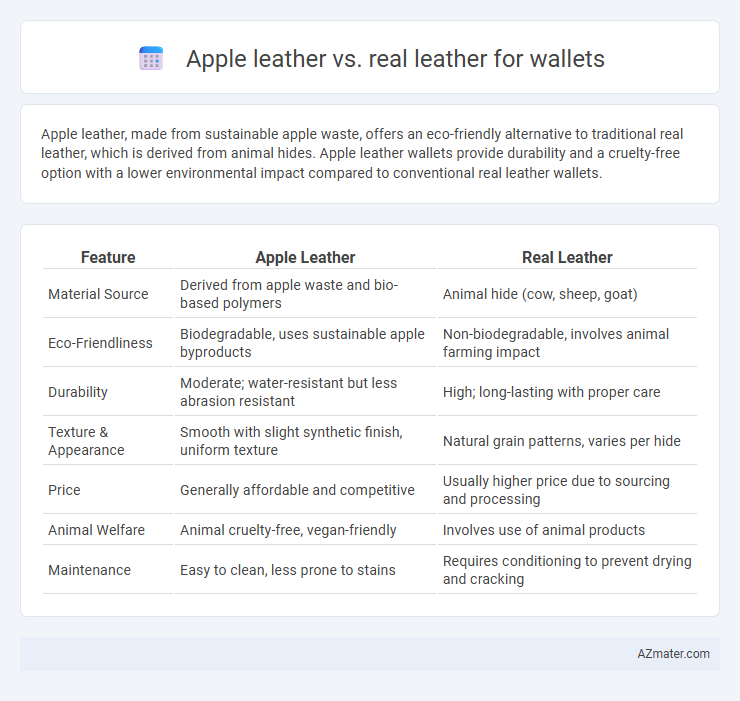Apple leather, made from sustainable apple waste, offers an eco-friendly alternative to traditional real leather, which is derived from animal hides. Apple leather wallets provide durability and a cruelty-free option with a lower environmental impact compared to conventional real leather wallets.
Table of Comparison
| Feature | Apple Leather | Real Leather |
|---|---|---|
| Material Source | Derived from apple waste and bio-based polymers | Animal hide (cow, sheep, goat) |
| Eco-Friendliness | Biodegradable, uses sustainable apple byproducts | Non-biodegradable, involves animal farming impact |
| Durability | Moderate; water-resistant but less abrasion resistant | High; long-lasting with proper care |
| Texture & Appearance | Smooth with slight synthetic finish, uniform texture | Natural grain patterns, varies per hide |
| Price | Generally affordable and competitive | Usually higher price due to sourcing and processing |
| Animal Welfare | Animal cruelty-free, vegan-friendly | Involves use of animal products |
| Maintenance | Easy to clean, less prone to stains | Requires conditioning to prevent drying and cracking |
Introduction to Apple Leather and Real Leather
Apple leather, a sustainable alternative made from apple peel waste, offers eco-friendly durability and a soft, natural texture ideal for wallets. Real leather, derived from animal hides, provides unmatched strength, longevity, and a classic, luxurious feel highly valued in traditional wallet craftsmanship. Both materials cater to different consumer preferences, with apple leather emphasizing environmental benefits and real leather focusing on premium quality and timeless appeal.
Material Origins: Apple Leather vs Real Leather
Apple leather is crafted from sustainable apple peels and fibers, offering an eco-friendly alternative that reduces waste and minimizes environmental impact. Real leather is derived from animal hides, primarily cows, involving resource-intensive processes such as tanning and chemical treatments. The choice between apple leather and real leather hinges on material origins, with apple leather providing a plant-based innovation and real leather reflecting traditional animal-derived craftsmanship.
Environmental Impact and Sustainability
Apple leather, made from sustainable apple waste, reduces reliance on animal farming and minimizes water consumption, making it a more eco-friendly choice than traditional real leather. Real leather production involves intensive land use, greenhouse gas emissions, and chemical pollutants from tanning processes, contributing significantly to environmental degradation. Choosing apple leather wallets supports circular economy principles and lowers carbon footprint, aligning with sustainable fashion practices.
Durability and Longevity Comparison
Apple leather, crafted from sustainable apple waste, offers impressive strength and resistance to cracking, making it a durable alternative to traditional leather. Real leather, derived from animal hide, typically boasts superior longevity and ages naturally with a unique patina that enhances its appearance over time. While apple leather is water-resistant and eco-friendly, genuine leather remains favored for its unmatched durability and ability to withstand prolonged wear and tear in wallets.
Aesthetic Appeal and Texture Differences
Apple leather wallet offers a smooth, consistent texture with a subtle grain pattern that mimics the look of traditional leather while providing a modern, eco-friendly aesthetic. Real leather wallet showcases a natural, unique texture with visible pores and irregular grain that develops character and richness over time. The aesthetics of Apple leather emphasize uniformity and sleekness, whereas real leather presents a classic, organic appeal with tactile depth.
Comfort and Daily Use Experience
Apple leather wallets, made from sustainable apple waste, offer a soft, smooth texture that enhances comfort during daily use by reducing stiffness common in some real leather products. Real leather wallets provide natural breathability and durability, developing a unique patina over time that increases comfort through personalized wear. Both materials withstand everyday handling well, but apple leather's vegan composition minimizes break-in periods and resists moisture better, making it ideal for users seeking low-maintenance comfort.
Maintenance and Care Requirements
Apple leather wallets require minimal maintenance, as their synthetic material resists stains and water, needing only occasional wiping with a damp cloth to stay clean. Real leather wallets demand regular conditioning with specialized leather care products to prevent drying and cracking, along with careful avoidance of water exposure. The durability of real leather improves with proper maintenance, while apple leather offers consistent performance with less effort over time.
Price and Accessibility
Apple leather wallets typically cost less than real leather ones, with prices varying based on brand and craftsmanship but often offering a more affordable alternative for consumers. Apple leather is more widely accessible, available through mainstream retailers and online platforms, contrasting with real leather wallets that can be pricier and sometimes limited to specialty stores. The synthetic nature of apple leather allows for consistent supply and broader distribution, enhancing its accessibility compared to the traditional tanning and sourcing requirements of genuine leather.
Ethical Considerations and Consumer Preferences
Apple leather, made from sustainable apple waste, offers an eco-friendly alternative to traditional real leather, reducing reliance on animal products and minimizing carbon emissions. Ethical considerations drive consumers toward apple leather wallets due to animal welfare concerns and environmental impact, while real leather retains popularity for its durability and natural texture. Consumer preferences increasingly favor apple leather for cruelty-free fashion, aligning with growing demand for sustainable and vegan-friendly products.
Final Verdict: Which Leather is Better for Wallets?
Apple leather offers a sustainable and eco-friendly alternative to traditional real leather, with excellent durability and a vegan-friendly production process that reduces environmental impact. Real leather, prized for its natural texture, longevity, and ability to develop a unique patina over time, remains a top choice for those seeking classic luxury and premium craftsmanship. For wallets, choosing between Apple leather and real leather depends on personal values: opt for Apple leather for ethical sustainability and real leather for timeless elegance and durability.

Infographic: Apple leather vs Real leather for Wallet
 azmater.com
azmater.com